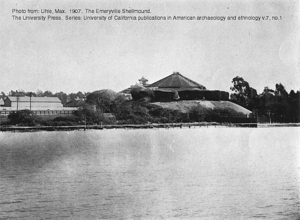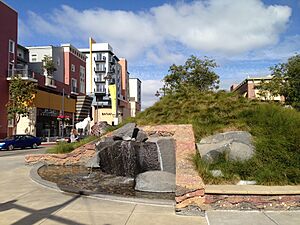Emeryville Shellmound facts for kids
Quick facts for kids Site of Shell Mound |
|
|---|---|

Shellmound and dance pavilion, in 1902
|
|
| Location | 4600 block of Shell Mound St., Emeryville, California |
| Reference no. | 335 |
| Lua error in Module:Location_map at line 420: attempt to index field 'wikibase' (a nil value). | |
The Emeryville Shellmound in Emeryville, California, was a very special place for the Ohlone people. It was a large mound made of shells and other things, used as a village, a temple, and a burial ground. This mound was one of several along the Temescal Creek near the San Francisco Bay. It was the biggest of more than 425 shellmounds found around the Bay Area. Today, the site of the Shellmound is a California Historical Landmark (#335).
Contents
A Look Back: The Shellmound's Story
Ancient Ohlone Life
For thousands of years, starting around 800 B.C., Native Americans called the Ohlone (or Costanoans) lived at this spot. The Ohlone people in the Bay Area spoke different languages. The Chochenyans, who lived in the Alameda County area, were a very advanced group. Many believe Emeryville was their main village.
The Shellmound was once a small hill, over 60 feet (18 m) high and about 350 feet (110 m) wide. It was connected to other smaller mounds. From its top, people could see amazing views of the Bay and the Golden Gate.
Archaeologists believe the Ohlone people built the Shellmound. It was mostly made of leftover shells and animal bones from their meals. Over many years, these leftovers grew into a huge pile covering a large area. People lived at this site for a very long time, from at least 2,800 years ago to about 400 years ago. It was also a sacred place where the Ohlone buried their dead.
When the University of California first studied this site in 1902 and again in the 1920s, they found many shells. These included clam, mussel, and oyster shells, along with many cockleshells.
From Sacred Site to Amusement Park
From the 1870s until 1924, a large amusement park called Shellmound Park operated on the site. The park had a racetrack, dance halls, a carousel, and a bowling alley. It even had a shooting range where national competitions took place. In the early 1900s, people showed off early flying machines at the racetrack. One of the dance halls was built right on top of the shellmound, offering great views of the bay. Shellmound Park was a very popular place for people from all over the San Francisco Bay Area.
However, when prohibition started in the 1920s (which banned alcohol), fewer visitors came. The park began to decline and was eventually sold.
Rediscovery and Modern Development
After the amusement park closed, a large industrial factory was built on the site. It operated from 1924 until 1999. When the factory was torn down in 1999, workers found parts of the Emeryville Shellmound again. Many people thought the mound had been completely destroyed when the factory was built.
Even though there were protests, construction continued. The ancient artifacts and remains were covered up once more. However, because the construction equipment in the 1920s was smaller, the original ground was not as damaged as people thought. In 1999, archaeologists confirmed that parts of the Emeryville Shellmound were still there.
Today, the site is home to the Bay Street Shopping Center. There is also a small park that serves as a memorial to the shellmound.
Protecting the Past
Starting in the mid-1800s, new soil and materials were placed over the Shellmound area. This was done to help build factories and other businesses. By the early 1900s, heavy industries like the Judson Steel company were built there. These factories were on top of a layer of new soil, which was about three to eight feet deep. This new soil came from construction waste, including debris from the 1906 San Francisco earthquake. Some of this waste also contained harmful chemicals.
In the 1980s, plans began to redevelop the Emeryville Shellmound area. Studies found high levels of chemicals like lead and zinc in the upper layers of soil. Luckily, most of this pollution did not go deep into the shellmound itself. Before the area was redeveloped, a lot of the contaminated soil was removed. During construction, archaeologists also found many ancient burials. Many people believe that hundreds more burials are still beneath the shopping center that was built.
Many groups opposed building the shopping mall on the sacred site. These included Native Americans, people who wanted to preserve history, and scientists. Many articles were written to support protecting the shellmound and recognizing it as a sacred place. A documentary movie was even made about it. Despite these efforts, the Emeryville City Council voted to build the Bay Street Shopping Mall.
Some people still feel upset that the mall was built. They believe the memorial park is not enough to honor the Ohlone people. On Black Friday (the day after Thanksgiving), Native Americans gather at the site to protest and teach shoppers about the history and importance of the Emeryville Shellmound.



